
The Sunday Mail

Garikai Mazara recently in Chimanimani
Ngangu and Kopa were the most ravaged when Cyclone Idai ravaged Chimanimani during the night of March 14 last year, but the tropical cyclone, the heaviest ever to hit the Southern Hemisphere, was to leave a trail of destruction across the whole district.
The Zimunda community, some 50-or-so kilometres from the epicentre was not spared, and just like the rest of the Chimanimani district, was cut off from the rest of the world. Bridges, roads, weir dams, irrigation plots were washed away.
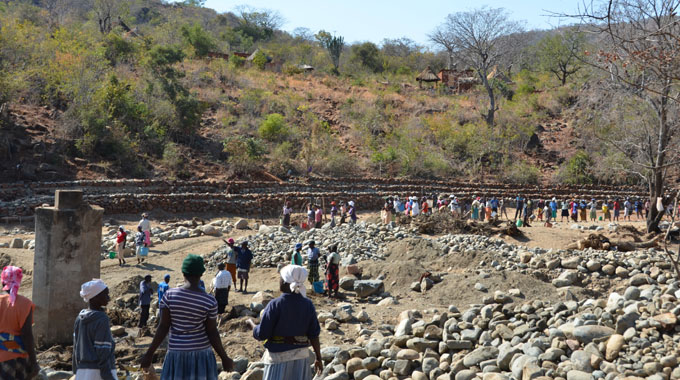
The Zimunda weir soon after Cyclone Idai was a reservoir of sand, stones and logs Pic Tatenda Macheka/WFP
“When we started assessing the damage Saturday morning, it was unbelievable what lay before our eyes, we had never seen such destruction,” recalled Lazarus Mauka. “Fine, we had hardly slept that Friday night, for fear of meeting death in our sleep and secondly because the downpour was so heavy – and so cold – one could hardly afford any sleep.”
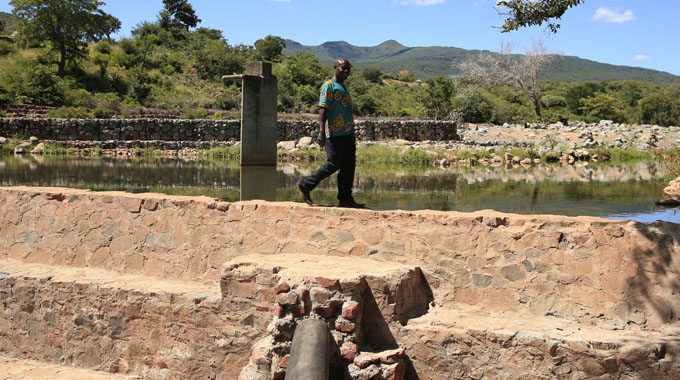
Lazarus Mauka walks on the crest of the rehabilitated Zimunda weir dam Pic Philimon Bulawayo/Reuters
That Saturday morning it was not easy to take account of the damage that the cyclone had caused, mainly because the raging water levels were still high. But as the day wore on, as Saturday gave in to Sunday, reality was slowly sinking into the community – they were coming to terms with the damage that had been wrought on their infrastructure.
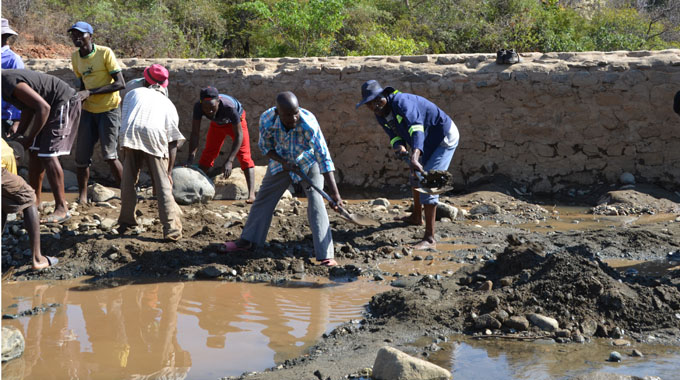
Under the food-for-assistance programme, 300 villagers from Zimunda work to rehabilitate their communal weir Pic Tatenda Macheka/WFP
Abigirl Mwarova, another resident, remembers the days in the aftermath of the cyclone very well. “First, we could not go outdoors, we just watched from within our homes, we were afraid the rains might come back and catch us outside.
“Then the nearby river was flowing ferociously, we could hear logs and stones crushing against each other. The sound made by the raging waters did not make matters any better. But as the waters receded, we went out to assess what had been left of our community.”
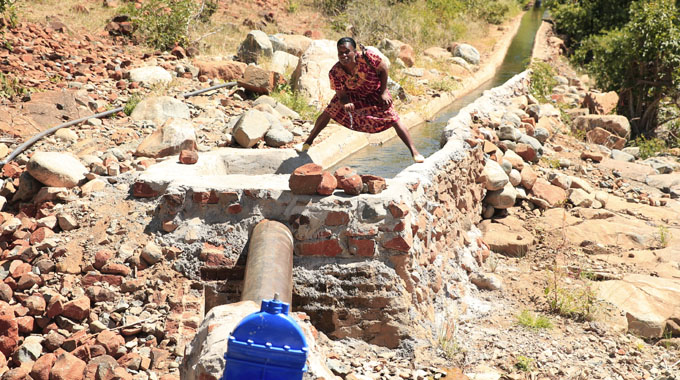
Abigirl Mwarova straddles the repaired and replaced pipeline that takes water to the irrigation scheme from Zimunda weir Pic Philimon Bulawayo/Reuters
Zimunda weir dam, a lifeline for the community, had been reduced to nothing but a reservoir of stones, sand and logs. The pipeline that drew water from the weir, downstream to the communal irrigation scheme, had been washed away.
“And to add salt to injury,” added Mwarova, “the irrigation plots had been washed away. We did not know where to start, what to do. The plots were our source of livelihood, we survive because of these irrigation plots but here were our lives, literally washed away.”
Mauka, who is the councillor for Ward 9, said not only were the irrigation plots washed away, but almost every other nutritional garden that lined up along Zimunda River had been washed away.
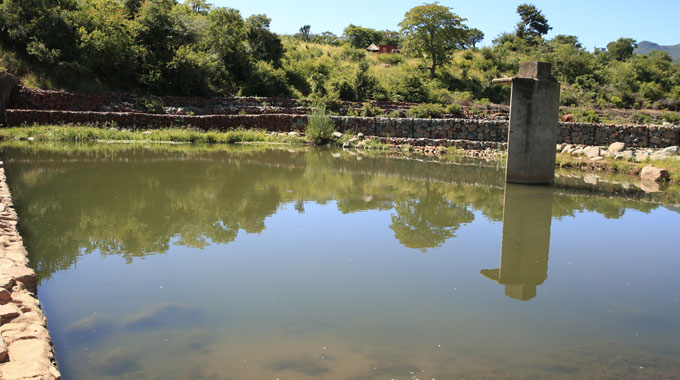
The refurbished Zimunda weir Pic Tatenda Macheka/WFP
“We had been taught that our gardens should be at least 30 metres away from the river bed, so that we don’t add silt to our rivers but the raging river swept away those gardens, 30 metres away either side of the river. This should give you an appreciation of how powerful the river was flowing.”
For some weeks in the aftermath of the disaster, food security became a matter of concern for the villagers, especially as they were marooned.
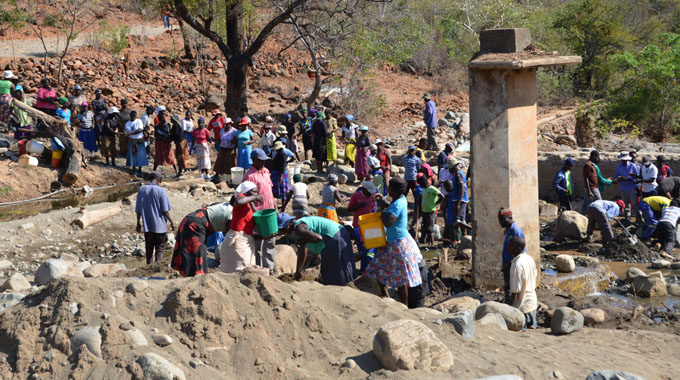
None but ourselves . . . the Zimunda community in Chimanimani work on rebuilding their weir in the aftermath of Cyclone Idai Pic Tatenda Macheka/WFP
“Initially we were helping each other, borrowing and lending, but the stocks were failing to match demand and we soon realised we had not stocked enough food. In any case, no-one anticipated that the cyclone will have such an impact on our lives,” recounted Mwarova.
But as the Zimunda community moved from the need for emergency food relief, there was a yawning gap as to how they would cope, in the long-term, from the climate-induced shock of Cyclone Idai.
Wherein moved the World Food Programme, with its implementing partner, World Vision, to ensure that the community builds resilience towards any such future shocks.
Incidentally, in the wake of Cyclone Idai, the World Food Programme was one of the first responders to the crisis, flying in the massive MI8 helicopter from Uganda to help mitigate the effects of the disaster. Within a week, the helicopter had moved three tonnes of relief food between Mutare and Chimanimani.
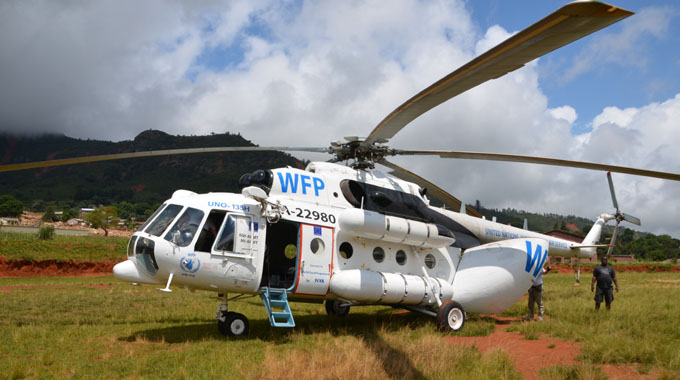
The WFP flew the MI8 helicopter to help Cyclone Idai emergency food relief efforts Pic WFP
But for the long haul, the not-for-profit organisation saw it better to build community resilience, of which the Zimunda weir dam was one of the projects earmarked for rehabilitation.
Zimunda and other 12 other resilience projects were funded by The World Bank, managed by Zimbabwe Idai Recovery Project (ZIRP), to reach the most affected communities across nine districts.
“The cyclone left the dam full of river sand, stones and logs. And the pipe that takes water downstream to our irrigation plots had been washed away.
“In-as-much as we would have wanted to work on bringing our lifeline back, we did not have the financial capacity to do so, especially in the wake of the cyclone,” said Mauka.
Whilst the community provided the labour, under the food-for-assets programme, the World Food Programme would provide the incentives, mostly in the form of food provisions.
The programme saw 300 people from the Zimunda community taking part, each contributing five hours per day, 15 days per month, and each getting US$45 equivalent for that month’s contribution.
“Besides giving us the financial incentives, the World Food Programme and its implementing partner also provided the materials that were needed to be bought, those that we could not provide as a community.
“For example, cement and pipes came from them and we used the sand and stones that had been deposited by the cyclone. They also provided the technical expertise, so that our weir was built with help from engineers.”
Joseph Kararadza, another villager, said Cyclone Idai did not only destroy infrastructure but livelihoods as well. “In the aftermath of the disaster, there was domestic disharmony in some households.
“Some of our young girls had resorted to unethical means to survive because families could no longer hold but when our irrigation scheme was restored, life came back to normal. We are now back to doing what we know best with our irrigation scheme and our lives are slowly getting back to normal.”
For Theodore Mudondo, her fears were on children getting malnourished. “Our biggest fear was on the return of kwashiorkor, we feared we were heading back in time. Malnutrition is something we last heard in this area long back but when our nutritional gardens were washed away, we feared that we could be heading back to the past.”
In a separate discussion prior to the visit to Chimanimani, Eddie Rowe, the country director for World Food Programme, commenting on his organisation’s thrust to rebuild community infrastructure, had hinted: “That is where the humanitarian development nexus comes in. When you go on the ground, you will find that there are several projects and efforts, not solely by WFP but a multi-sectorial approach, through the World Bank funded Zimbabwe Idai Response Project, to re-construct the lives of the people of Chimanimani and Chipinge.”
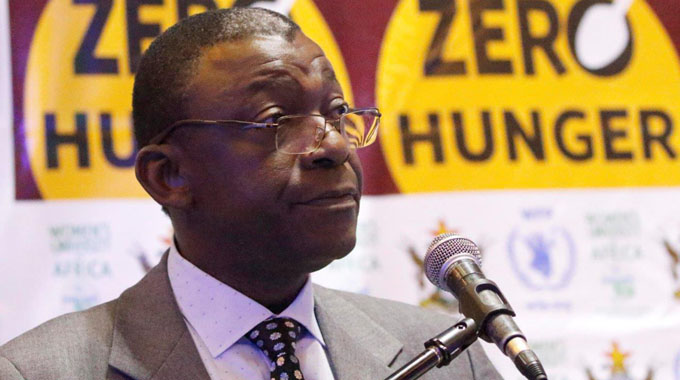
Eddie Rowe, the World Food Programme country director Pic WFP
Whilst Cyclone Idai might have come and gone, its ravaging effects still being felt, the Zimunda community is ready for any other climate-induced shock that might come its way.
Councillor Mauka could not have summed it better: “These climate-induced shocks are not just cyclones, they can be droughts, but we are sure that our community is ready to take in any other shock that might come our way, thanks to the rehabilitation of our weir. Our worry might only come if we go for, say two seasons, without rains, which is unusual though.”



